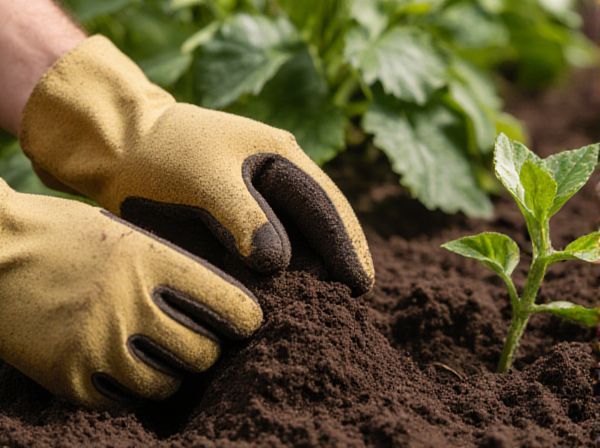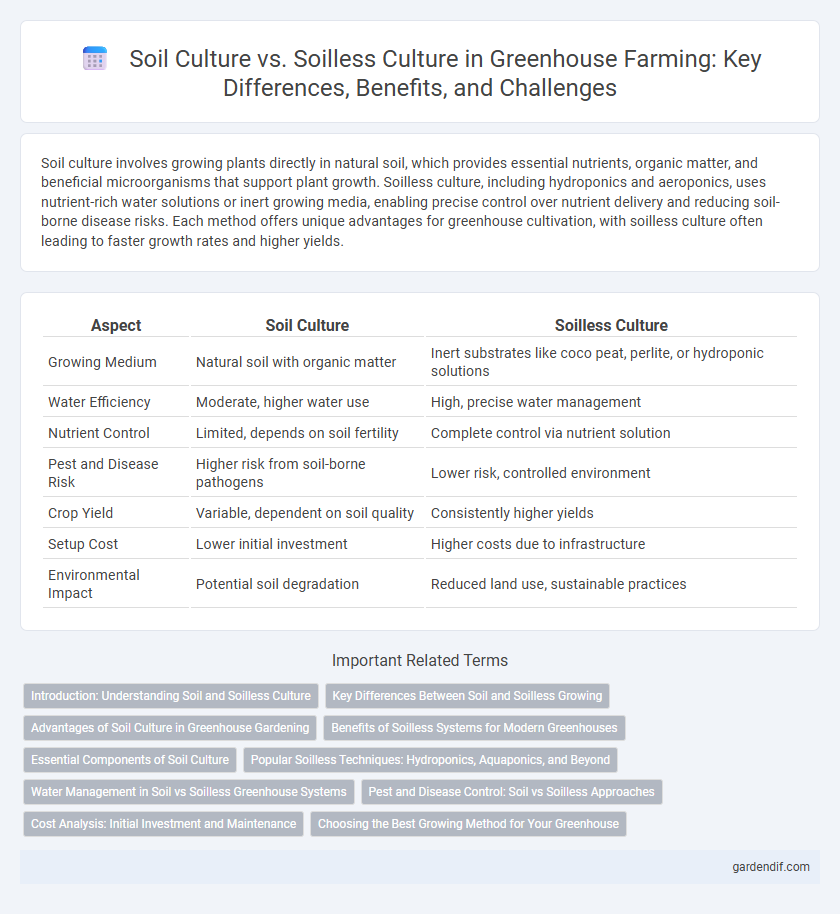
Soil Culture vs Soilless Culture Illustration
Soil culture involves growing plants directly in natural soil, which provides essential nutrients, organic matter, and beneficial microorganisms that support plant growth. Soilless culture, including hydroponics and aeroponics, uses nutrient-rich water solutions or inert growing media, enabling precise control over nutrient delivery and reducing soil-borne disease risks. Each method offers unique advantages for greenhouse cultivation, with soilless culture often leading to faster growth rates and higher yields.
Table of Comparison
| Aspect | Soil Culture | Soilless Culture |
|---|---|---|
| Growing Medium | Natural soil with organic matter | Inert substrates like coco peat, perlite, or hydroponic solutions |
| Water Efficiency | Moderate, higher water use | High, precise water management |
| Nutrient Control | Limited, depends on soil fertility | Complete control via nutrient solution |
| Pest and Disease Risk | Higher risk from soil-borne pathogens | Lower risk, controlled environment |
| Crop Yield | Variable, dependent on soil quality | Consistently higher yields |
| Setup Cost | Lower initial investment | Higher costs due to infrastructure |
| Environmental Impact | Potential soil degradation | Reduced land use, sustainable practices |
Introduction: Understanding Soil and Soilless Culture
Soil culture involves cultivating plants in natural soil, which provides essential nutrients and microbial activity critical for plant growth. Soilless culture, such as hydroponics and aeroponics, uses nutrient-rich water or inert mediums, enabling precise control over nutrient delivery and reducing soil-borne diseases. Understanding the distinct characteristics of soil and soilless culture is vital for optimizing greenhouse productivity and resource efficiency.
Key Differences Between Soil and Soilless Growing
Soil culture relies on natural earth substrates rich in organic matter and microbes, providing plants with essential nutrients and structure for root growth. Soilless culture, including hydroponics and aeroponics, uses inert mediums like coco coir or rockwool, allowing precise control over water, oxygen, and nutrient delivery. Key differences lie in nutrient management, root environment control, and reduced risk of soil-borne diseases in soilless systems, optimizing growth conditions for higher yields in greenhouse cultivation.
Advantages of Soil Culture in Greenhouse Gardening
Soil culture in greenhouse gardening offers natural nutrient retention and microbial activity that enhances plant growth and soil health. This method provides better water-holding capacity and buffering against pH fluctuations, promoting stable root development. Using soil also supports beneficial organisms that help suppress soil-borne diseases, reducing reliance on chemical treatments.
Benefits of Soilless Systems for Modern Greenhouses
Soilless culture in modern greenhouses, such as hydroponics and aeroponics, offers precise control over nutrient delivery and water usage, enhancing plant growth efficiency and yield quality. These systems reduce soil-borne diseases and pest risks, leading to healthier crops and lower reliance on chemical pesticides. Soilless culture also enables space optimization and year-round production, making it highly suitable for urban and vertical farming environments.
Essential Components of Soil Culture
Essential components of soil culture in greenhouses include nutrient-rich soil, proper aeration, and adequate moisture retention to support root development and plant growth. Organic matter such as compost enhances soil fertility by supplying essential macro and micronutrients, while soil texture and structure influence water drainage and root penetration. Maintaining balanced pH levels and beneficial microbial activity further optimizes nutrient availability and plant health in soil-based cultivation systems.
Popular Soilless Techniques: Hydroponics, Aquaponics, and Beyond
Soilless culture techniques in greenhouses, such as hydroponics and aquaponics, maximize plant growth by delivering nutrients directly through water, eliminating soil-borne diseases and nutrient variability. Hydroponics utilizes nutrient-rich solutions to support plant roots, optimizing resource use and boosting yield efficiency. Aquaponics integrates aquaculture with plant cultivation, creating a sustainable ecosystem where fish waste provides natural fertilizer, enhancing both plant and aquatic life productivity.
Water Management in Soil vs Soilless Greenhouse Systems
Water management in soil culture relies on precise irrigation techniques to maintain optimal moisture levels, preventing waterlogging and ensuring nutrient availability through soil retention. In soilless culture, such as hydroponics, water use is highly efficient due to recirculation systems that minimize waste and allow direct nutrient delivery to plant roots. These differences significantly impact water conservation strategies, with soilless systems offering greater control over water quality and consumption in greenhouse environments.
Pest and Disease Control: Soil vs Soilless Approaches
Soilless culture in greenhouses significantly reduces the risk of soil-borne pests and diseases, offering cleaner root environments compared to traditional soil culture. Hydroponic and aeroponic systems minimize pathogen presence by controlling nutrient solutions and substrate conditions, leading to fewer infestations and less reliance on chemical treatments. In contrast, soil culture requires rigorous soil sterilization and crop rotation to manage nematodes, fungi, and bacterial pathogens that persist in soil ecosystems.
Cost Analysis: Initial Investment and Maintenance
Soil culture requires lower initial investment due to the availability of natural soil but incurs higher maintenance costs related to pest control, soil management, and fertilizers. Soilless culture demands a higher upfront cost for substrates, nutrient solutions, and specialized equipment but benefits from reduced labor, water usage, and disease management expenses. Over time, soilless systems often yield better cost efficiency through optimized resource use and higher crop productivity in controlled greenhouse environments.
Choosing the Best Growing Method for Your Greenhouse
Soil culture relies on natural soil layers rich in organic matter, providing essential nutrients and microbial activity for plant growth, which is ideal for crops that thrive in traditional environments. Soilless culture, including hydroponics and aeroponics, offers precise control over nutrient delivery and reduces soil-borne diseases, optimizing growth rates and yield in controlled greenhouse settings. Selecting the best method depends on crop type, space availability, resource management, and desired productivity outcomes within your greenhouse.
Soil Culture vs Soilless Culture Infographic

 gardendif.com
gardendif.com